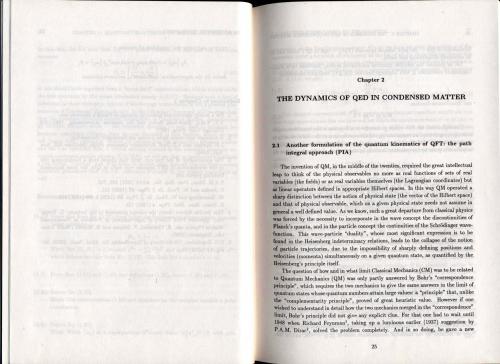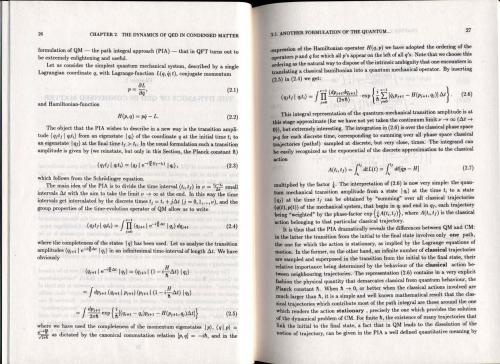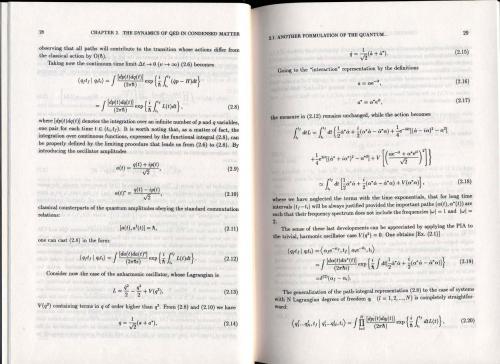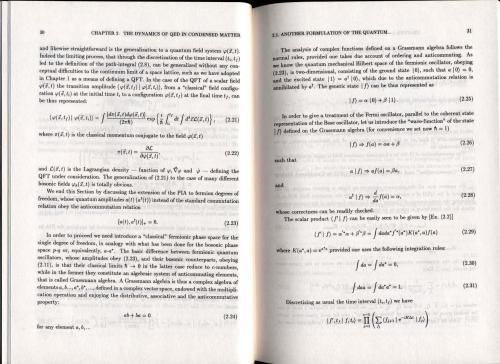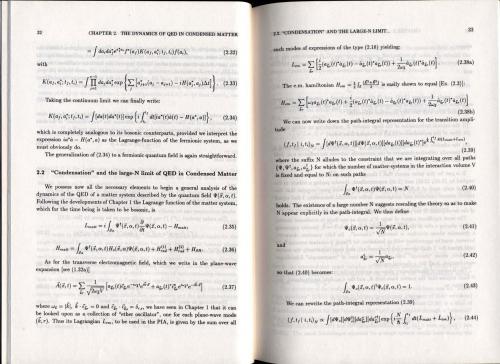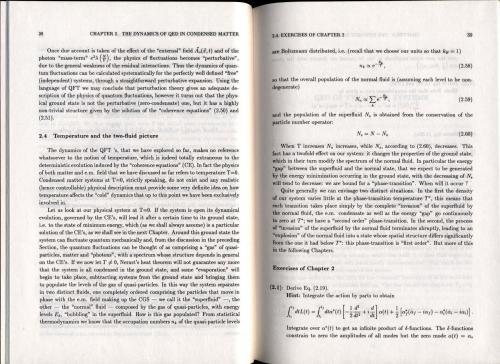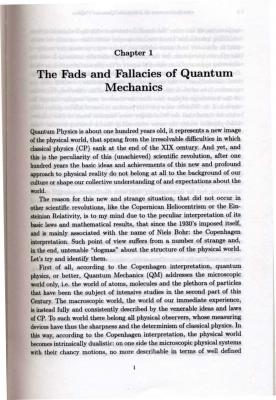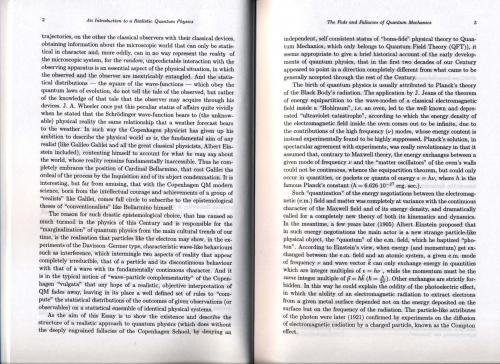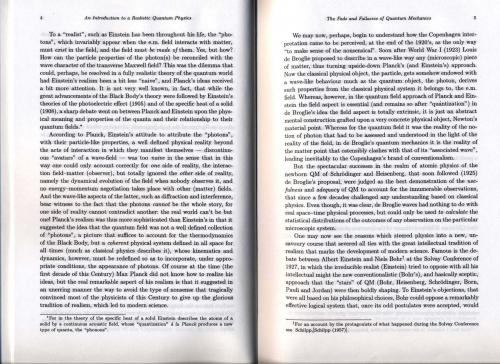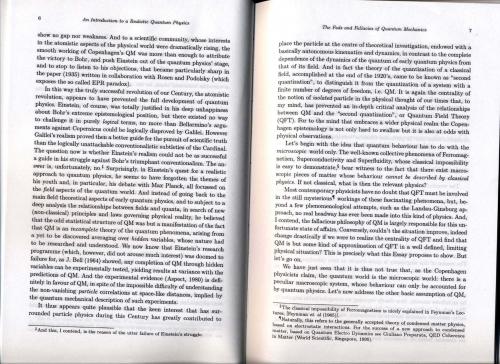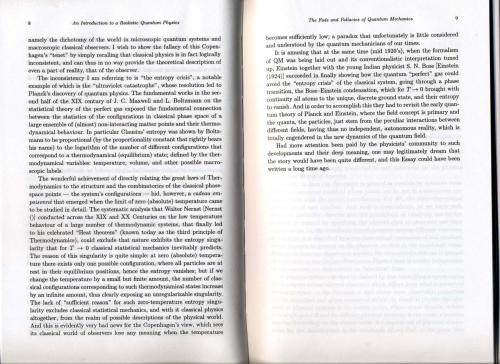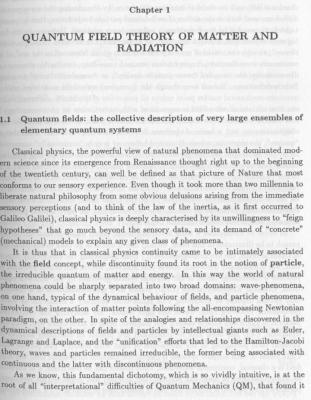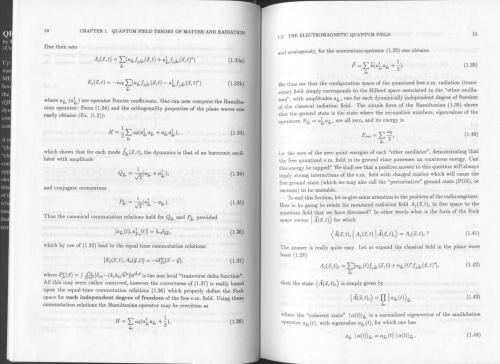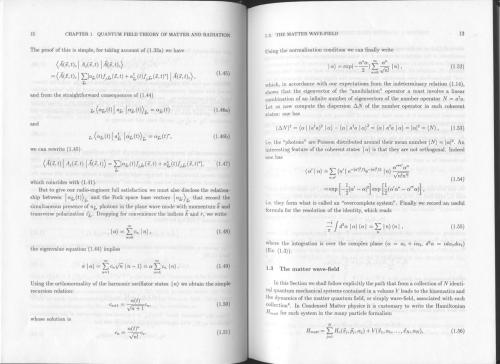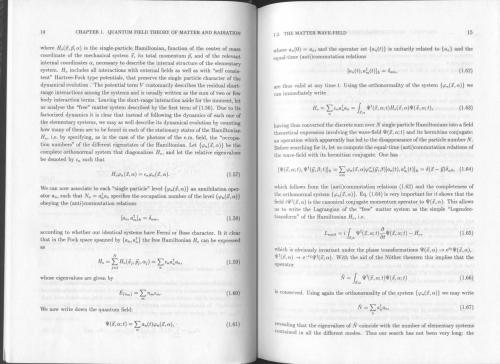-
Posts
8 -
Joined
-
Last visited
Profile Information
-
Favorite Area of Science
theoretical physics
mgb2's Achievements

Lepton (1/13)
0
Reputation
-
Dear Advaithi, what you think about these pages ? Thanks mgb2
-
Dear ajb, what's wrong ? why nobody is replying ? Thanks mgb2
-
Ok, I think this first chapter add no particular new notions about the ones that are already known. It is just to begin to handle with the language of QFT and the major points are related to describe both the matter and the e.m. wave-field as a collection of harmonic oscillators in the respective Hamiltonians on a proper Fock space. Now the operators are the fields, which can be expanded as in 1.61 and the vectors of the Fock space can be written in form of coherent states, which can be expressed as an infinite superposition of the eigenvectors of the number operator. Now, when we talk about annihilation and creation operators acting upon some state, we don't have to think to destroy or create a particle as in high energy physics but to the creation or destruction of a quasi-particle (excitation) in a particular mode of the field. Basically this means that the number operator is conserved. Another aspect is related to the difference in between coherence and long-range order. If you consider the Bose gas of a fixed number N of non interacting elementary systems the correlation function is not zero but the order parameter expectation value is zero instead, because a0|N>0=c|N-1>0 and 0<N|N-1>0=0 in 1.80. The important notion to remind here is that of the Perturbative Ground State (PGS), well explained at pag 19 and the Coherent Ground State (CGS) 1.93 arising from the simple introduction of a two-body short-range interaction as in 1.81 and stemming from the fact that coherence over long distances demands an interacting theory that cannot be treated perturbatively. Now let's go ahead with the second chapter to see what happen, in QFT, to the wave-particle duality with the well know problem of trajectory in QM and the effect of simply rescaling the theory let the particle number to appear in the transition amplitude 2.39. Thanks for your attention mgb2
-
Hi Advaithi, That's because you are referring to an incomplete theory (QM) and then you have an incomplete understanding of the reality. The reality come if you consider as basic the Quantum field e not the particle, defined for each space-time point. The particle is only the distilled of the field, its quantum. When you interact with a matter field (i.e. you measure some of its microscopic properties) the particle aspect dominate. When you don't interact with it the reality is that of a "classical" field with a wave behaviour. To be more clear: a laser physicist or a radio-engineering simply are not interested in the number of photons of the e.m. field but only in the phase of their wave. The same concept holds in the case of matter when you are interested in probing at micro or at macroscopic scale. It is a field. The Quantum wave-field of matter (Dirac) and radiation (Gauge) in interaction.
-
Dear swanson, you are absolutely true, but the condensed matter systems I' talking about is ordinary matter with high density and temperature far from absolute zero. This shall imply a profound difference in the behavior and in theoretical approximations. mgb2
-
Thanks ajb, I'll start by uploading the first chapter of the book and let you the time to read before discussing all together. When you all will be ready please start with questions and let me know if there is something wrong. I don't think there is violation to copyright if only a part of the book is publicized. Anyway, if I am wrong I will delete them immediately and we will find another way to discuss about it Thanks mgb2
-
Hi to everibody, I'm a researcher working on mgb2 superconducting tape fabrication with a great passion for theoretical physics. Recently I was reading a textbook about a new way to threat condensed matter systems (with N=1023) in terms of QED who can be useful for my research field but very difficult (for me) to understand. The basic lacuna that this book wish to fill in the analysis of condensed matter systems is the generalized neglect of the electro-dynamical interaction of the elementary systems with the electro-magnetic radiation field A(x,t). Please, excuse me if I don't give you the book title and the author name but I would like to discuss in a situation without any prejudice. The ideas expressed in this book may seems sometimes difficult to accept from the scientific community and my QFT understanding is not so high (maybe too low) to distinguish if whether or not these ideas are just "difficult to be accepted" or simply wrong. So, I would ask you all if is possible to begin here a sort of "theory testing" in which, step by step, the theory will be shown and you shall find all of its possibly weaknesses. Thanks in advance. mgb2
-
Hi to all, I'm a researcher working on mgb2 superconducting tapes in Italy and my passion is about theoretical physics.



